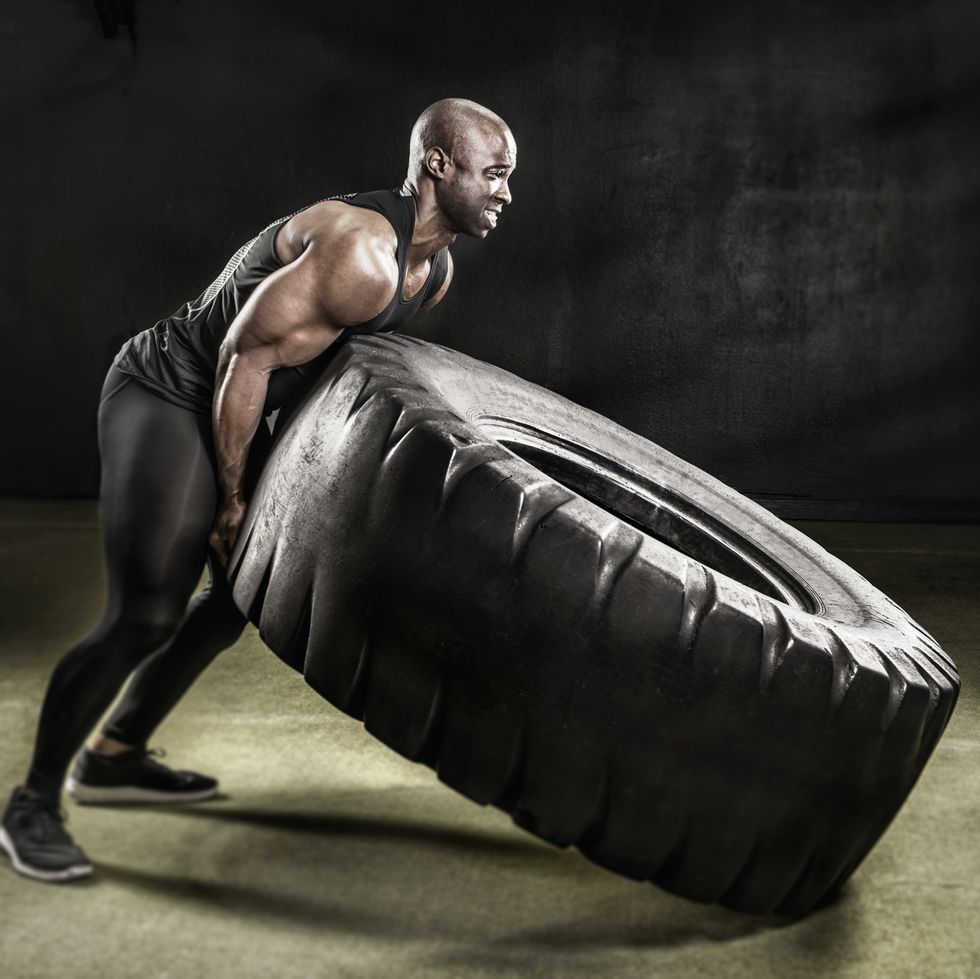These 10 tips can help you pack on muscle and strength.
It’s not easy to build muscle. Every guy knows that.
Yes, you go into the gym, and you lift weights, and you may seem some gains. But if you really want to pack on serious size and muscle, you need a plan, and it’s more than randomly picking up a few dumbbells, and slamming through some reps and sets.
Instead, there are defined tactics, both in terms of diet and in terms of training, that get you the results you want. And those tactics are generally take a bit of planning. “Workouts without a plan just won’t get you to the goals you want,” says MH fitness director Ebenezer Samuel, C.S.C.S. “You need a strategy.”
That strategy doesn’t need to be so rigid that it leaves no room for fun. Quite to the contrary, you can still enjoy a good meal, and you don’t need to spend hours in the gym, as long as, when you’re in the gym, you’re training smart. These tips can help, whether you’re a beginner or somebody who’s just at a training plateau.
The 10 Principles to Pack On Muscle
1. Maximize Muscle Building
The more protein your body stores—in a process called protein synthesis—the larger your muscles grow. But your body is constantly draining its protein reserves for other uses—making hormones, for instance.
The result is less protein available for muscle building. To counteract that, you need to “build and store new proteins faster than your body breaks down old proteins,” says Michael Houston, Ph.D., a professor of nutrition at Virginia Tech University.
Shoot for about 1 gram of protein per pound of body weight, which is roughly the maximum amount your body can use in a day, according to a landmark study in the Journal of Applied Physiology.
For example, a 160-pound man should consume 160 grams of protein a day—the amount he’d get from an 8-ounce chicken breast, 1 cup of cottage cheese, a roast-beef sandwich, two eggs, a glass of milk, and 2 ounces of peanuts. Split the rest of your daily calories equally between carbohydrates and fats.
2. Eat More
OATMEALSTORIESGETTY IMAGES
In addition to adequate protein, you need more calories. Use the following formula to calculate the number you need to take in daily to gain 1 pound a week. (Give yourself 2 weeks for results to show up on the bathroom scale. If you haven’t gained by then, increase your calories by 500 a day.)
- A. Your weight in pounds: _____
- B. Multiply A by 12 to get your basic calorie needs: _____
- C. Multiply B by 1.6 to estimate your resting metabolic rate (calorie burn without factoring in exercise): _____
- D. Strength training: Multiply the number of minutes you lift weights per week by 5: _____
- E. Aerobic training: Multiply the number of minutes per week that you run, cycle, and play sports by 8: _____
- F. Add D and E, and divide by 7: _____
- G. Add C and F to get your daily calorie needs: _____
- H. Add 500 to G: _____. This is your estimated daily calorie needs to gain 1 pound a week.
3. Work Big, Not Small
Yes, biceps curls are fun, but if you want to put on muscle, you have to do more to challenge your body. And one key to doing that, says Samuel, is working through so-called “multi-joint” movements. “Yes, isolation training has value,” says Samuel, “but it can’t be the backbone of your training.”
Instead, you want to do exercises that challenge multiple joints and muscles at once. Take, for example, a dumbbell row. Every row rep challenges biceps, lats, and abs. Using multiple muscle groups allows you to lift more weight, says Samuel, a key stimulator of growth (more on that later). And it pushes you to use muscles together, just as you do in real life. “Multi-joint moves are key in your workouts,” he says.
Make sure moves like squats, deadlifts, pullups, and bench presses are in your workout to take advantage of that. All will stimulate multiple muscle groups at the same time, and in order to grow, you want to do that.
4. Train Heavy
If you want to build muscle and strength, you have to train heavy, says Curtis Shannon, C.S.C.S. “Training heavy, safely and efficiently, has many benefits,” says Shannon. “Heavy training challenges the muscles not only concentrically but eccentrically. If dont right, the stimulus of heavy weight going down with control and going back up will cause greater muscle tear and rebuild.”
That means not every set you do should have you pumping out 10-15 reps. Yes, high-rep sets can have value, but for multi-joint moves like squats and bench presses, and deadlifts, don’t be afraid to do sets of, say, 5 reps. That’ll allow you to use more weight, building more pure strength, says Samuel. And as you progress, that new strength will allow you to lift heavier weights for more reps.
One way you can approach this in your training: Lead off every workout with an exercise that lets you train low-rep. Do 4 sets of 3-5 reps on your first exercise, then do 3 sets of 10-12 reps for every move after that. “It’s the best of both worlds,” says Samuel, “letting you build pure strength early, then pile up reps later.”
5. Have a Drink First
A 2001 study at the University of Texas found that lifters who drank a shake containing amino acids and carbohydrates before working out increased their protein synthesis more than lifters who drank the same shake after exercising.
The shake contained 6 grams of essential amino acids—the muscle-building blocks of protein—and 35 grams of carbohydrates.
“Since exercise increases bloodflow to your working tissues, drinking a carbohydrate-protein mixture before your workout may lead to greater uptake of the amino acids in your muscles,” says Kevin Tipton, Ph.D., an exercise and nutrition researcher at the University of Texas in Galveston.
For your shake, you’ll need about 10 to 20 grams of protein—usually about one scoop of a whey-protein powder. Can’t stomach protein drinks? You can get the same nutrients from a sandwich made with 4 ounces of deli turkey and a slice of American cheese on whole wheat bread. But a drink is better.
“Liquid meals are absorbed faster,” says Kalman. So tough it out. Drink one 30 to 60 minutes before your workout.
6. Don’t Always Go Hard
Your body should move every day, but that doesn’t mean your workouts should take you to fatigue and exhaustion. “If you train your hardest every day, your body doesn’t get a chance to grow,” says Samuel. “Pick your spots to attack.” Aim to finish every workout feeling good, not dead. Limit your weight room workouts to 12-16 total sets of work, and never go beyond that.
This doesn’t mean you can’t take on a brutal workout every so often. But limit workouts that take your body to its breaking point to three times a week, never on back-to-back days. “You need recovery to grow,” says Samuel. “Constantly training to the point of exhaustion will be counterproductive to the recovery you need for muscle growth.”
7. Down the Carbs After Your Workout
Research shows that you’ll rebuild muscle faster on your rest days if you feed your body carbohydrates.
“Post-workout meals with carbs increase your insulin levels,” which, in turn, slows the rate of protein breakdown, says Kalman. Have a banana, a sports drink, a peanut-butter sandwich.
8. Eat Something Every 3 Hours
“If you don’t eat often enough, you can limit the rate at which your body builds new proteins,” says Houston.
Take the number of calories you need in a day and divide by six. That’s roughly the number you should eat at each meal. Make sure you consume some protein—around 20 grams—every 3 hours.
9. Make One Snack Ice Cream
This tip will be the easiest to follow by far: Have a bowl of ice cream (any kind) 2 hours after your workout.
According to a study in the American Journal of Clinical Nutrition, this snack triggers a surge of insulin better than most foods do. And that’ll put a damper on post-workout protein breakdown.
10. Have Milk Before Bed
Eat a combination of carbohydrates and protein 30 minutes before you go to bed. The calories are more likely to stick with you during sleep and reduce protein breakdown in your muscles, says Kalman.
Try a cup of raisin bran with a cup of skim milk or a cup of cottage cheese and a small bowl of fruit. Eat again as soon as you wake up.
“The more diligent you are, the better results you’ll get,” says Kalman.
The Whey To Go for Muscle Growth
Drink this protein power shake before every workout.
Weight-gain powders seem like an easy solution to a skinny guy’s problems. After all, they pack as many as 2,200 calories into one serving. But you’re not getting what you pay for.
“High-calorie weight-gain drinks usually get more than 80 percent of their calories from sugar,” says Doug Kalman, R.D. And downing that much sugar can give you an upset stomach and diarrhea.
So, in a sense, you’re flushing good money down the toilet. “You’ll get much better results by spreading your calories throughout the day,” says Kalman.
And by using protein shakes. Look for whey protein powders at nutrition stores. Combine one scoop of the powder with the following ingredients and blend for a homemade muscle-building pre-workout shake:
- 1 tsp olive or flaxseed oil
- 1/2 c fat-free yogurt
- 1 c grape or apple juice
Stats per shake: 335 calories, 27 gram protein, 45 grams carbohydrates, 6 grams fat


